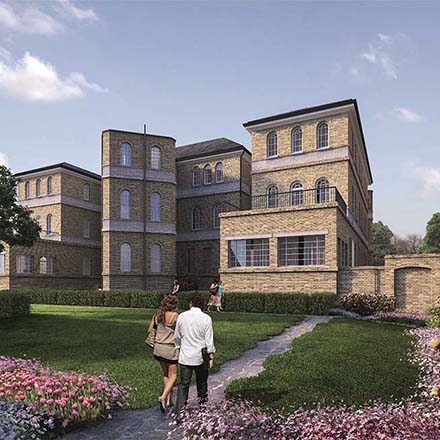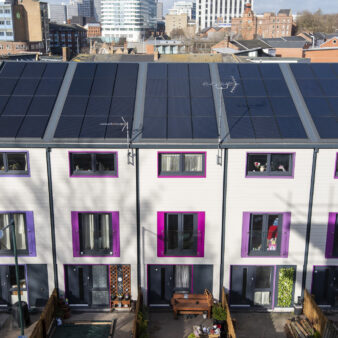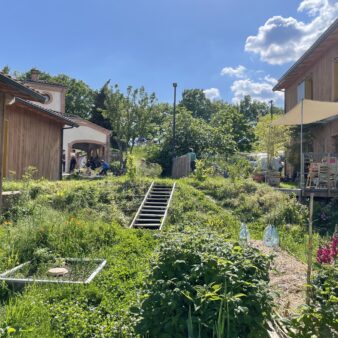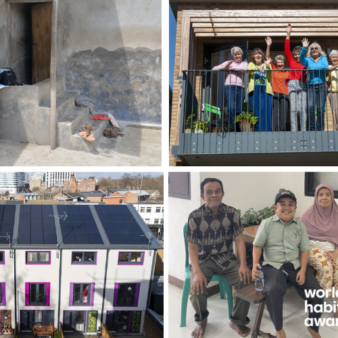
Truly affordable housing in Mile End, London is being made possible thanks to a development backed by local residents.
While the UK’s capital is widely regarded as having the hottest of housing markets, even more under the microscope while in the grip of the current housing crisis, a community land trust is showing how creating affordable housing is achievable with the backing, input and enthusiasm of its local community.
London Community Land Trust, the first urban community land trust (CLT) in the UK, is building 23 homes for low-cost ownership as part of a 252-dwelling, award-winning redevelopment of a former hospital site, St Clements in Mile End, Tower Hamlets. Applications for the homes, to be completed in stages through 2016 and due to be ready to buy in August, are now closed, with sale prices, linked to local wages, of between one third and one quarter of the market rate for the area.
For local people the development offers a lifeline to be able to afford to stay in a neighborhood that means so much to them. “For families like ours, the market has priced us out of staying in the area I love where we live – it’s where our friends are, where the children go to school, where they play, where we often work and volunteer,” says local resident Suzanne Gorman. “St Clement’s offers us a properly affordable way of owning a home here.”
While the development has been far from simple, sitting within a conservation area and with two of the hospital buildings Grade 2 listed, local residents have played an integral role in the design process with more than 350 people taking part in community planning workshops in order to contribute to the project.
Calum Green, London CLT’s Communities and Campaigns Director, believes the model should play a big part in combating the current housing crisis, providing genuinely affordable homes for those in the capital and other regions across the country.
“To create better places to live, both in terms of the bricks and mortar and the management and ownership involved, it’s crucial to involve people in the process throughout”, says Calum. London CLT is making a case for affordability to be linked to local incomes, with any property bought through the scheme at income-linked rates to be sold on using the same formula, making it sustainably affordable. “The affordable ownership of their property encourages a pride in it, a greater sense of accountability, feeling more invested in its maintenance and creating a positive sense of community for the long term.”
To achieve this, the CLT is working with developer Galliford Try, alongside partners Linden Homes, JTP Architects, the Greater London Authority and Peabody, taking an approach never before tried in the UK. This involves the following:
- With funding from commercial lenders, the developer builds 23 homes which London Community Land Trust buys as they are completed. These are immediately sold on to a pre-selected owner to repay the loan.
- The sale cost of each of the 23 homes is directly linked to median local incomes, not their market value.
- The gap in the market value of these homes and the price they are sold for is funded by cross subsidy from the remaining 178 homes on the site for market sale.
- The 23 homes for low-cost ownership are being provided in addition to 51 homes let at social rents being provided by Peabody on site.
- A panel, working for, and selected by, London Community Land Trust, selects future homeowners based on their housing need, local connection and ability to secure a mortgage.
- Each future owner raises their own mortgage finance, with support from the Trust.
- London CLT ensures a resale price is included in the lease, compelling owners to sell to the next household at a price that is linked directly to rises in median incomes since they purchased it.
London CLT isn’t resting on the laurels of its success with the St Clements site, however. It is already building on its achievement and experience to deliver more affordable homes across the capital, and has an agreement with Lewisham Council for a site that will deliver 10–15 new homes.
For this venture they plan to organise their own development. “We’re thinking of ways to engage even more comprehensively with the community, to involve them from the outset with planning and delivery,” says Calum. “This would allow genuine and frank conversations with residents to get consensus about what would excite them about the development, what they would really like, and if it is practical and affordable to do. It would also open up the possibility of employing apprentices to work on the development, offering local employment and training opportunities.”
On top of this, the CLT also have commitments from Southwark, Croydon and Redbridge Councils for a number of CLT homes to be built in their boroughs. “CLTs provide a way for all Londoners, regardless of background, to have a place in this city,” says Calum. “There are hundreds of sites in London that could help build genuinely affordable homes like this, and we have every intention of building lots more.”
Financing was kickstarted by a community share offer, launched in February, which aims to raise a total of £450k via crowdfunding. Investments offer a 5% return and although this target hasn’t been reached, with the share offer due to close at the end of this month (May 2016), the CLT are confident they’ll raise at least £250k, which will go a huge way towards realising their ambitions.




Join the discussion